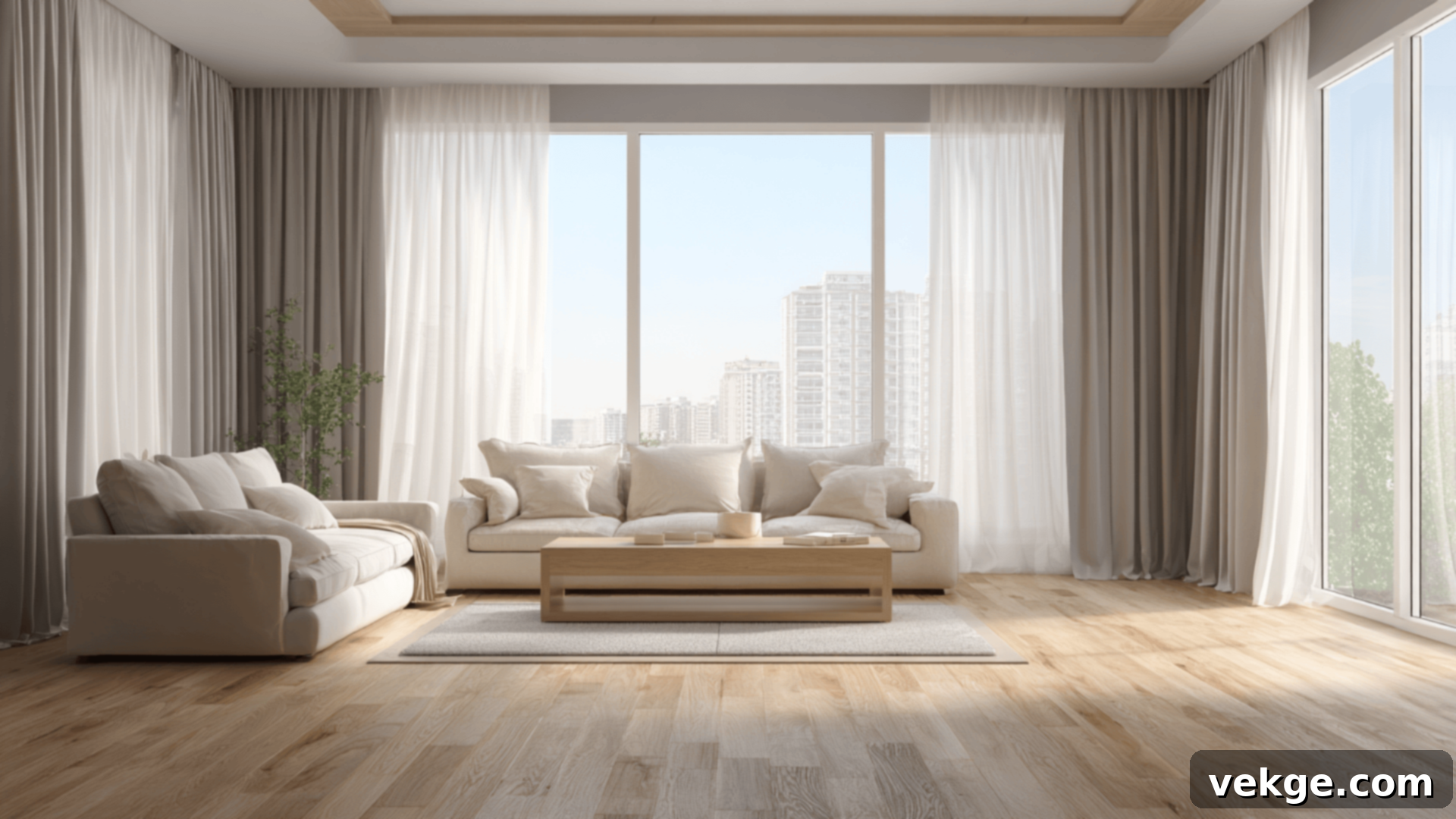Ultimate Guide to Choosing the Perfect Curtain Length for Every Room
Finding the right curtain length is one of those design details that can dramatically transform the feel of a room. It’s a common question, and for good reason—too short, and your windows can look awkward and unfinished; too long, and you risk a messy, dust-collecting pile of fabric. The ideal curtain length balances practicality with aesthetics, elevating your home decor and creating the perfect ambiance.
This comprehensive guide is designed to remove all the guesswork from selecting curtain lengths. We’ll dive deep into standard curtain sizes, walk you through precise measuring techniques, and explore which lengths and styles work best for various rooms and window types. Beyond the basics, you’ll discover common curtain mistakes to avoid and simple, impactful tips that ensure your window treatments look professionally installed and impeccably stylish.
Whether you’re aiming for a casual, light-filled space or a luxurious, dramatic statement, understanding the nuances of curtain length is key. By the end of this guide, you’ll have all the knowledge you need to choose curtains that not only fit your windows perfectly but also enhance your home’s unique style.
Understanding Standard Curtain Lengths
Curtains are typically sold in standard lengths, making it easier to find options that suit common window and ceiling heights. While custom options offer endless possibilities, knowing these standard measurements provides an excellent starting point for your selection process. Each length is designed to achieve a specific look and function, from practical to opulent.
| Curtain Length | Best For | Description / Style Benefit |
|---|---|---|
| 63 inches | Kitchens, bathrooms, small windows | Hangs cleanly below the windowsill, preventing fabric from interfering with countertops or water. Offers a casual, neat, and highly practical look that is easy to maintain and clean. |
| 84 inches | Bedrooms, living rooms, dining rooms (standard 8-foot ceilings) | This popular length stops approximately ½ inch above the floor, creating a crisp, tailored finish. It’s a versatile choice that avoids fabric dragging and is ideal for active households or those who frequently open and close their curtains. |
| 96 inches | Living rooms, master bedrooms (higher 9-foot ceilings) | Designed to just touch the floor, or “kiss” it, this length creates an elegant, elongated appearance. It makes rooms feel taller and adds a touch of sophistication without the excessive pooling of fabric, perfect for a refined yet inviting atmosphere. |
| 108 inches | Formal living rooms, large bedrooms (tall 10-foot ceilings) | This length is ideal for enhancing grand windows and drawing the eye upward, significantly contributing to the room’s perceived height and spaciousness. It offers a dramatic and graceful aesthetic, often seen in more formal or luxurious settings. |
| 120 inches | Grand rooms, oversized windows, very tall ceilings (10+ feet) | Curtains of this length typically “puddle” on the floor, meaning they gather several inches of fabric at the bottom. This creates an opulent, custom-styled, and highly dramatic effect, best suited for decorative panels in less trafficked, formal areas where elegance is prioritized over practicality. |
Precise Measuring for Perfect Curtain Length
Accurate measurements are the foundation of beautifully hung curtains. A small miscalculation can lead to a look that feels off, so taking the time to measure correctly is crucial. Follow these detailed steps to ensure your curtains hang perfectly and complement your space.
Step 1: Decide on Curtain Rod Placement
Before you even pick up a tape measure, visualize where your curtain rod will be installed. For a classic and visually appealing look, mount the curtain rod 4 to 6 inches above the window frame. This placement helps to make the window appear taller and more substantial. If you desire to create an illusion of even greater height, consider placing the rod closer to the ceiling, sometimes just a few inches below the crown molding. The rod should also extend 6 to 12 inches beyond the window frame on each side, allowing the curtains to be pulled back fully and let in maximum light.
Step 2: Choose Your Desired Curtain Hanging Style
The way your curtains meet the floor fundamentally impacts their final length and the overall aesthetic of the room. Decide on your preferred style upfront:
- Float: The curtain fabric stops approximately ½ inch above the floor. This style is practical, modern, and ensures easy movement.
- Kiss: The curtain fabric just barely touches the floor, creating a clean, tailored, and sophisticated finish.
- Puddle: The fabric extends past the floor by 1 to 6 inches, gathering slightly. This creates a luxurious, romantic, and dramatic effect.
Your choice here will directly influence the final length you’ll measure for your curtains.
Step 3: Measure from the Rod to the Floor
With your rod placement decided, grab a metal tape measure. Start at the exact point where the top of your curtain rod will be mounted. Extend the tape measure straight down to the floor, ensuring it is held taut and perfectly vertical. This measurement represents the raw length needed for your curtains. Write this number down carefully.
Step 4: Adjust for Your Chosen Style
Now, modify your raw measurement based on the hanging style you selected in Step 2:
- To achieve the Float look, subtract ½ inch from your raw measurement.
- For the Kiss style, use your raw measurement as the exact curtain length.
- If you prefer the dramatic Puddle effect, add 1 to 6 inches to your raw measurement, depending on how generous you want the puddle to be (1-3 inches for a slight puddle, 4-6 inches for a more abundant one).
Step 5: Measure Both Sides of the Window
It’s a common misconception that floors and windows are perfectly level. To avoid a lopsided appearance, measure from the rod placement to the floor on both the left and right sides of your window. Always use the longer of the two measurements. This simple tip ensures your curtains will hang evenly and look polished, even if your floor is slightly uneven.
Inside vs. Outside Mount: Understanding the Difference
Your mounting choice also influences the visual effect and, sometimes, the measuring process:
- An inside mount involves installing the curtain rod or hardware inside the window frame itself. This creates a very neat, streamlined appearance and is ideal for showcasing beautiful window trim. However, it requires a window frame that is deep enough to accommodate the hardware, and it may not block as much light as an outside mount.
- An outside mount positions the curtain rod above and/or beyond the window frame. This is the most popular and versatile option. It allows you to make windows appear larger, provides superior light blocking and privacy, and offers a more dramatic, layered look. For floor-length curtains, an outside mount is almost always preferred to achieve that elegant, expansive feel.
Exploring Different Curtain Hanging Styles
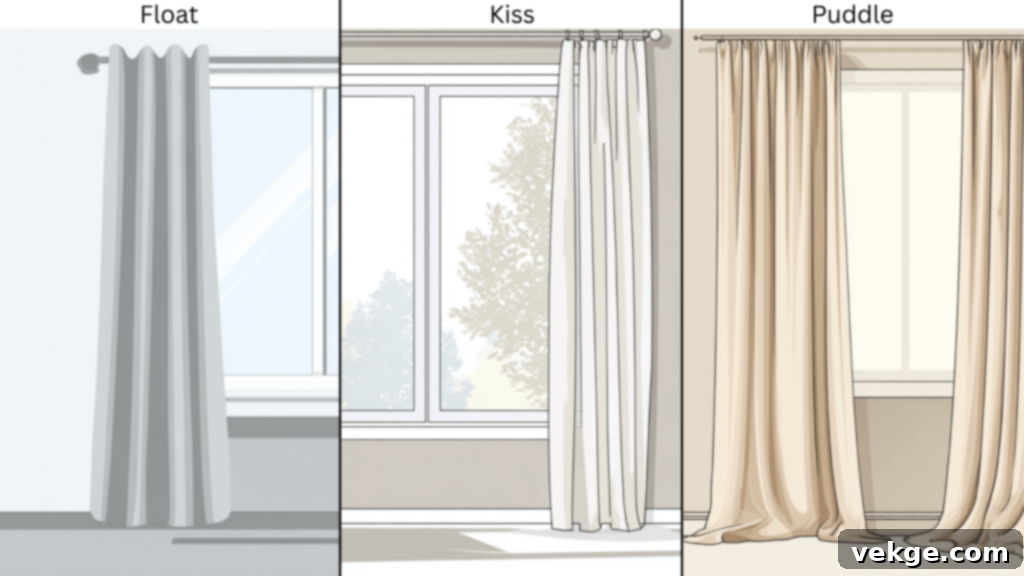
The way your curtains gracefully meet the floor profoundly influences the ambiance of your entire room. These three primary styles are the most common, each lending itself beautifully to different situations, desired aesthetics, and levels of maintenance.
1. The Float (½ Inch Above the Floor)
Description: In this style, the bottom edge of the curtain panel rests approximately ½ inch above the floor. It creates a crisp, clean line that is visually uncluttered and modern.
Benefits: This look is exceptionally neat and practical. Curtains that float are effortless to open and close, as there’s no fabric dragging on the floor. This means less wear and tear, and importantly, they are less likely to collect dust, pet hair, or dirt. It’s an ideal choice for high-traffic areas, homes with pets or small children, or anyone seeking a low-maintenance window treatment.
Best for: Everyday use, contemporary spaces, active households, kitchens, children’s rooms, and situations where functionality is paramount.
Avoid if: You’re aiming for a dramatically elegant, luxurious, or intensely cozy and relaxed feel, as the float style is more about crispness.
2. The Kiss (Just Touching the Floor)
Description: The fabric of the curtain panel just barely skims or “kisses” the floor. There is no excess fabric, simply a delicate touch.
Benefits: This style delivers a highly tailored, polished, and sophisticated appearance. It’s elegant without being overly ornate, offering a refined look that suggests custom-fit quality. The kiss style helps to elongate the visual line of the window, making ceilings appear higher and adding a sense of grandeur to the room. It’s a classic choice that works well in many design aesthetics.
Best for: Living rooms, formal dining rooms, master bedrooms, or any space where you desire an elevated, sophisticated, and clean aesthetic.
Avoid if: Your floors are significantly uneven, as even a slight variation can make the curtains appear lopsided. Also, avoid if you prioritize absolute minimal effort in cleaning or frequently move your curtains across the floor.
3. The Puddle (1–6 Inches on the Floor)
Description: Curtains designed with a puddle extend past the floor, allowing the fabric to gather in a gentle, romantic pool at the bottom. The depth of the puddle can vary from a subtle 1-2 inches to a lavish 5-6 inches.
Benefits: This look feels incredibly soft, luxurious, and inherently romantic or dramatic. Puddled curtains are often chosen for traditional, opulent, or bohemian-inspired spaces where texture and visual weight are desired. They can help conceal slightly uneven floors and add a grand, custom-designed touch that speaks of relaxed elegance.
Best for: High-ceiling rooms, formal living rooms, master bedrooms, decorative panels that aren’t often opened, and spaces where you want to create a grand, opulent, or artistic statement.
Avoid if: You need to open and close your curtains daily, have young children or pets (as the fabric can be a tripping hazard or collect more hair/dirt), or if you prefer a very minimalist and practical aesthetic.
Curtain Length for Different Types of Windows
Just as rooms have distinct personalities, so do windows. Matching the curtain length and style to your specific window type ensures a harmonious and functional design. Here’s how to approach various window shapes and sizes:
- Arched Windows: The key here is to celebrate the arch, not conceal it. Opt for floor-length curtains that are mounted on a straight rod placed strategically above the arch. This frames the beautiful curve of the window while allowing the natural light to stream in. Custom panels are often best to achieve clean, tailored lines that complement the unique architectural feature.
- Bay Windows: Bay windows offer a beautiful architectural feature but can be tricky. Use flexible or angled curtain rods that precisely follow the contour of the bay. Choose curtain panels that either “kiss” the floor or “float” just above it. This soft, polished look enhances the bay’s unique structure without adding bulk or impeding movement. Consider individual panels for each section of the bay for maximum flexibility.
- Small or Narrow Windows: To make small windows appear larger and more significant, avoid overwhelming them with too much fabric. Stick to 63-inch or 84-inch curtains, mounted high and wide. Use wider curtain panels (even if the window itself is narrow) or sheer fabrics to visually expand the window’s presence. Hanging the rod well beyond the window frame tricks the eye into perceiving a wider opening, creating a sense of openness and light.
- Picture Windows & Large Fixed Panes: These windows are often meant to showcase a view. Floor-length curtains (96-108 inches) hung high and wide are ideal. They frame the view beautifully, add softness, and can provide privacy and light control when needed, without obstructing the window’s main purpose.
- Sliding Glass Doors: For functional reasons, curtains for sliding glass doors should always be floor-length (84-120 inches depending on ceiling height) and easily movable. A “float” or “kiss” style is most practical to avoid snagging. Ensure the rod extends well beyond the door frame so the curtains can be fully drawn back, providing unobstructed access and maximum light.
Thoughtful consideration of your window’s characteristics and the surrounding architecture will guide you to the perfect curtain length, enhancing both form and function.
How Curtain Length Impacts Room Style and Perception
Beyond simply covering a window, your curtains are powerful design elements that significantly influence the entire feel and perceived dimensions of a room. Even seemingly minor details, such as rod height or how much fabric gathers at the floor, can profoundly impact your space.
Creating an Illusion of Height with Rod Placement
One of the oldest and most effective interior design tricks is using curtains to make a room feel taller than it actually is. Mounting your curtain rod significantly higher than the window frame—typically 4 to 6 inches, but sometimes even closer to the ceiling—immediately draws the eyes upward. This simple adjustment creates a vertical visual line that extends from near the ceiling down to the floor, making the walls appear longer and the room feel more expansive and grand.
Complementing this high rod placement with longer curtains (96, 108, or even 120 inches) further enhances this illusion. The continuous flow of fabric from near the ceiling to the floor eliminates visual breaks, contributing to a sense of uninterrupted height and spaciousness. This technique is particularly effective in rooms with standard or lower ceilings, transforming them from cozy to soaring.
Matching Curtain Length to Room Function and Desired Style
The ideal curtain length isn’t just about aesthetics; it also aligns with the practical function and desired mood of each room:
- Casual and Practical Spaces (Kitchens, Bathrooms, Children’s Playrooms): Shorter curtains (63 inches) that fall below the windowsill are most practical here. They prevent fabric from getting wet, stained, or caught, ensuring hygiene and ease of use. This length naturally conveys a more casual, tidy, and lighthearted feel, perfect for bustling or functional areas.
- Cozy and Inviting Spaces (Bedrooms, Family Rooms): Longer curtains (84-96 inches) that either kiss or float just above the floor contribute significantly to a sense of warmth and comfort. They offer better insulation, privacy, and light control, essential for restful bedrooms or relaxed living areas. The full, soft look of floor-length panels feels warm, complete, and inviting.
- Formal and Dramatic Spaces (Formal Living Rooms, Dining Rooms, Master Suites): For rooms where elegance and grandeur are paramount, opt for longer lengths (96-120 inches) with a “kiss” or “puddle” style. Puddled curtains, in particular, add an undeniable touch of luxury and drama, signaling a sophisticated and intentional design. These lengths create a rich, enveloping atmosphere, perfect for entertaining or creating a serene retreat.
By thoughtfully considering how each room is used and the atmosphere you wish to cultivate, you can select curtain lengths that not only fit perfectly but also reinforce your home’s unique style and enhance everyday living.
Room-by-Room Curtain Length Guide
Each room in your home presents a unique set of needs and design opportunities. The ideal curtain length should always complement the room’s function, reflect your desired aesthetic, and contribute to its overall harmony.
1. Kitchen
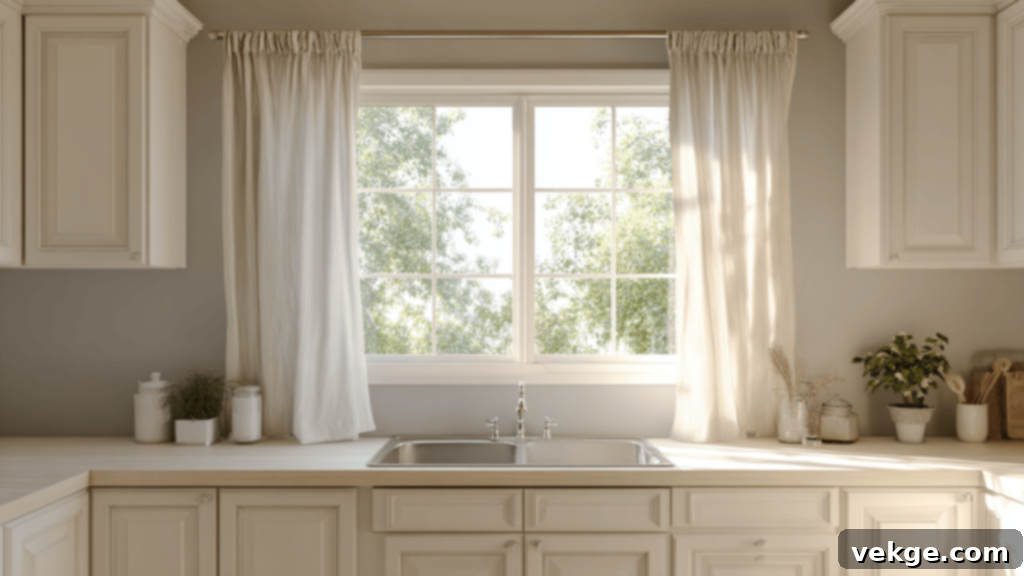
For the kitchen, practicality reigns supreme. Shorter curtains, typically 63 inches, are almost always the best choice. This length ensures the curtains hang neatly below the windowsill, keeping them well away from water, food splatters, and busy countertops. It prevents them from becoming a fire hazard near stovetops and makes cleaning a breeze. This length fosters a casual, clean, and airy look, which is perfect for a functional space. Consider light, washable fabrics like cotton or linen blends for optimal maintenance.
2. Bathroom
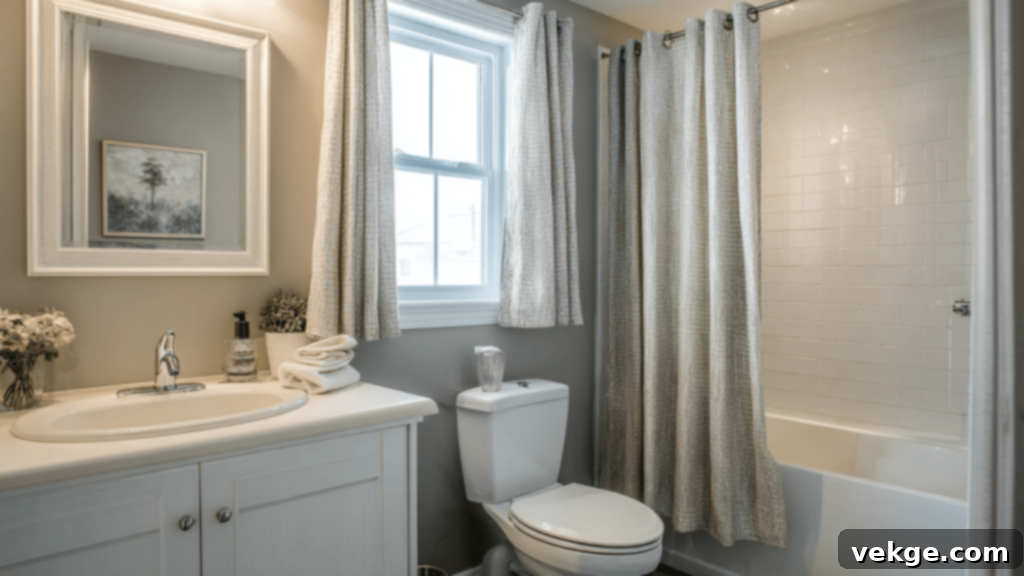
Similar to kitchens, bathrooms benefit greatly from shorter curtains to manage moisture and maintain hygiene. Curtains that stop at or below the windowsill (63 inches) prevent dampness, mold, and mildew from developing on the fabric. They are easy to wash and help keep the space feeling fresh and clean. Unless you have a very large, well-ventilated bathroom with no risk of splash or humidity affecting floor-length fabric, it’s best to stick to shorter, lightweight, and often sheer or semi-sheer options for privacy and light.
3. Living Rooms
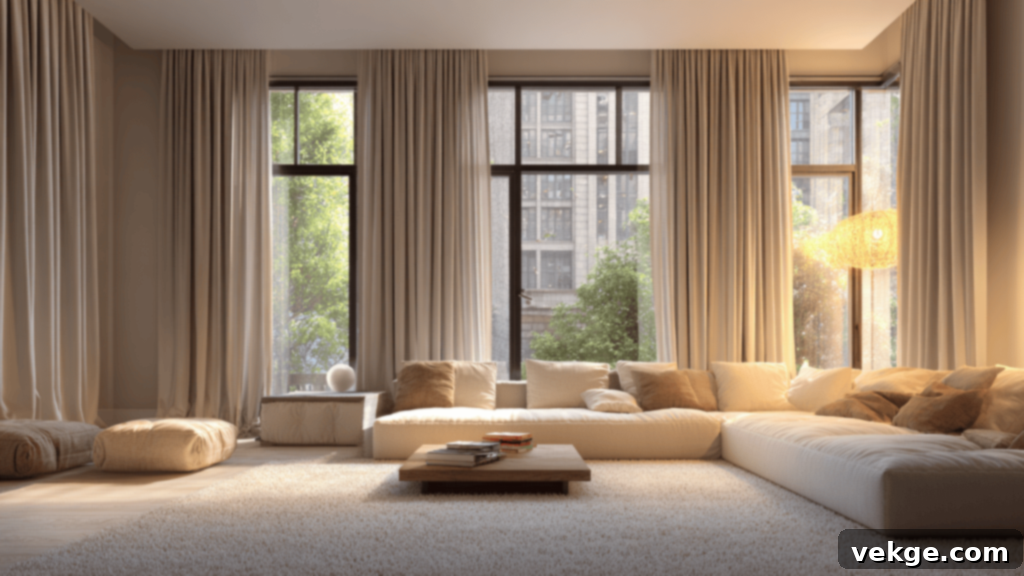
The living room is an excellent place to embrace a touch of drama and elegance with longer curtains. Full-length curtains, ranging from 84 to 108 inches, are highly recommended. Mounting them high and wide makes the room feel grander, more spacious, and incredibly polished. For a sophisticated look, choose panels that just “kiss” the floor. If your style leans towards opulent or traditional, a slight “puddle” can add a luxurious, relaxed feel. Layering sheer and opaque panels can also enhance functionality and visual interest in this central gathering space.
4. Bedroom
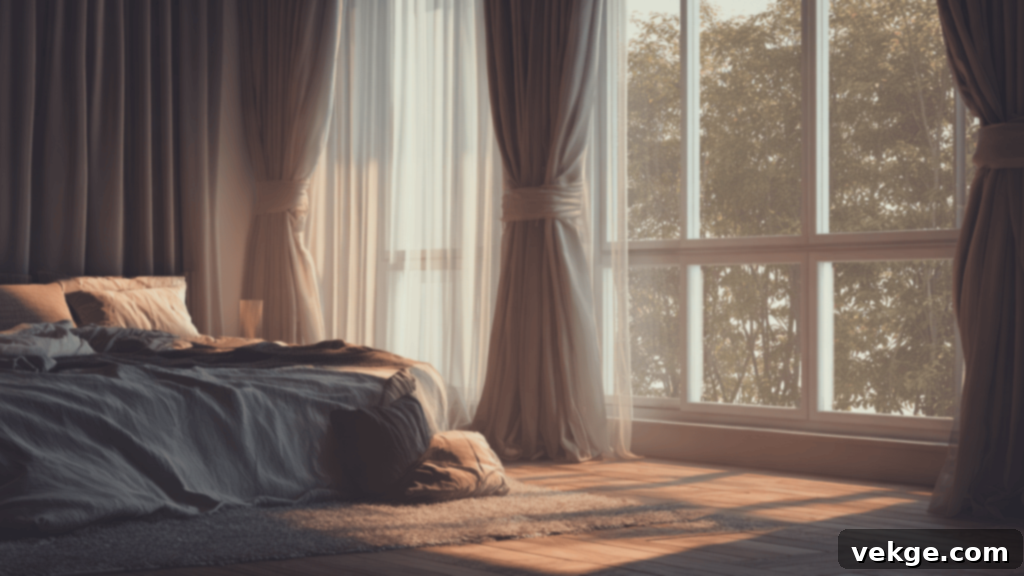
In the bedroom, you can choose between a cozy, restful retreat or a grand, hotel-inspired ambiance. 96-inch panels that “kiss” or “float” the floor create a soft, serene, and tidy look conducive to sleep. For a more luxurious or romantic feel, especially in a master suite, consider 108-120 inch curtains with a generous “puddle.” Blackout linings are often essential in bedrooms, so ensure your chosen length accommodates the added weight and fullness. The goal is to create a peaceful, enveloping space that feels both stylish and highly comfortable.
5. Dining Room and Office
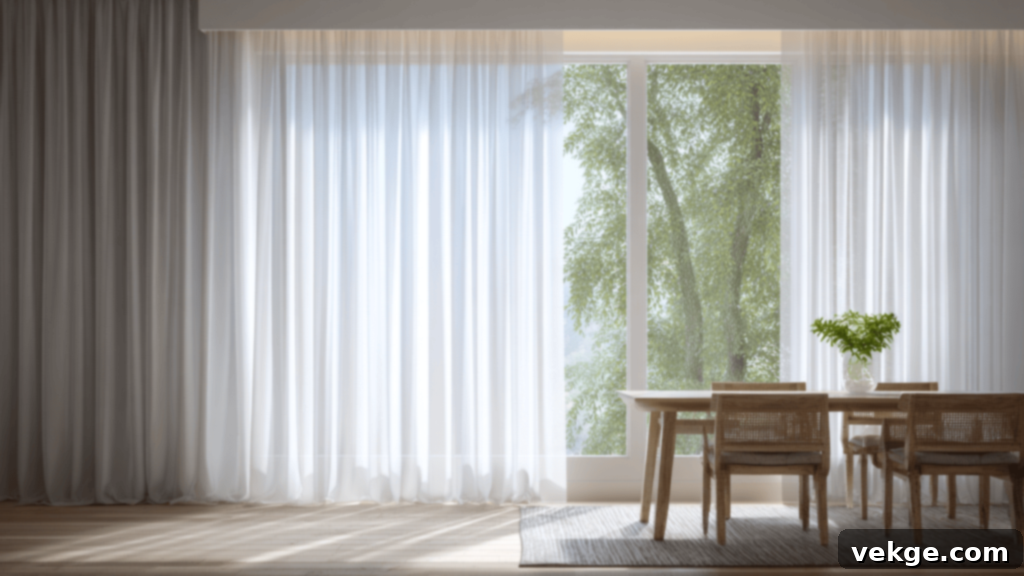
For dining rooms and home offices, the focus is often on balance, professionalism, and clean lines. Floor-length curtains (84 or 96 inches) that hang straight and neatly are the ideal choice. A “kiss” or “float” style creates a simple, elegant, and professional touch without being distracting. This ensures the space feels polished and complete, fostering an environment suitable for focused work or enjoyable meals. Consider fabrics that offer some light filtering without being too heavy, maintaining a bright yet controlled atmosphere.
Common Curtain Length Mistakes to Avoid
Even seasoned decorators can occasionally overlook small details when it comes to curtains. A seemingly minor error in choosing or hanging your curtain panels can significantly detract from the overall aesthetic of a room. Being aware of these common pitfalls will save you time, effort, and ensure a polished finish.
- Curtains That Are Too Short: This is arguably the most common and visually jarring mistake. Panels that stop several inches or even a foot above the floor look awkward, unfinished, and can make your windows appear undersized. Always aim for curtains that at least “float” or “kiss” the floor. Curtains that hover create an immediate sense of imbalance and cheapen the look of an otherwise well-designed room.
- Curtain Rod Mounted Too Low: Placing the curtain rod directly above the window frame is a missed opportunity. This practice visually shortens the room, making ceilings feel lower and windows less imposing. To maximize perceived height and grandeur, always mount rods 4 to 6 inches (or even higher) above the window frame, extending them beyond the frame on either side.
- Curtain Panels That Are Too Narrow: Curtains should appear full and luxurious, whether open or closed. If your panels are too narrow, they will look skimpy, stretched, and unable to provide adequate coverage or privacy. For a rich, gathered look, your total curtain width should be at least 2 to 2.5 times the width of your window. Insufficient fullness makes curtains appear like an afterthought rather than a thoughtful design element.
- Ignoring Uneven Floors: Relying on a single measurement can lead to curtains that appear lopsided. Floors, especially in older homes, are rarely perfectly level. Always measure the distance from your intended rod placement to the floor on both the left and right sides of the window. Using the longer measurement will ensure that even the lowest point of your curtain adequately meets the floor, preventing an uneven hemline.
- Skipping Style Adjustments: Forgetting to factor in your preferred hanging style (float, kiss, or puddle) into your final measurement is a recipe for disappointment. A raw floor-to-rod measurement needs to be adjusted; otherwise, your “kiss” might end up “floating,” or your “puddle” could become a “kiss.” Always add or subtract the necessary inches based on your desired curtain style for the perfect final look.
By consciously avoiding these common curtain length and hanging mistakes, you’ll ensure your window treatments not only fit perfectly but also significantly enhance the beauty and sophistication of your entire room.
Curtain Fullness and Width Guide for a Luxurious Look
While length dictates how your curtains meet the floor, width, or “fullness,” determines how richly they drape and frame your windows. Panels that are too narrow will look flat and uninviting, lacking the luxurious gather that elevates a room. Understanding how to calculate ideal panel width and choose appropriate fabrics is crucial for achieving that coveted, designer look.
How to Calculate Ideal Curtain Panel Width

To determine the perfect curtain fullness, begin by accurately measuring the total width of your window, including any trim or frame you intend to cover. Once you have this measurement, multiply that number by 2 to 2.5. This calculation gives you the ideal total curtain width needed for a lush, gathered appearance when the curtains are closed. For example, if your window measures 60 inches wide, you should aim for a total curtain width between 120 and 150 inches. If you plan to use two curtain panels, simply divide this total width by two to get the ideal width for each individual panel. This generous fullness allows the fabric to create beautiful folds and pleats, adding depth and richness to your window treatment rather than appearing flat or stretched.
Fabric Types That Drape Better for Enhanced Fullness
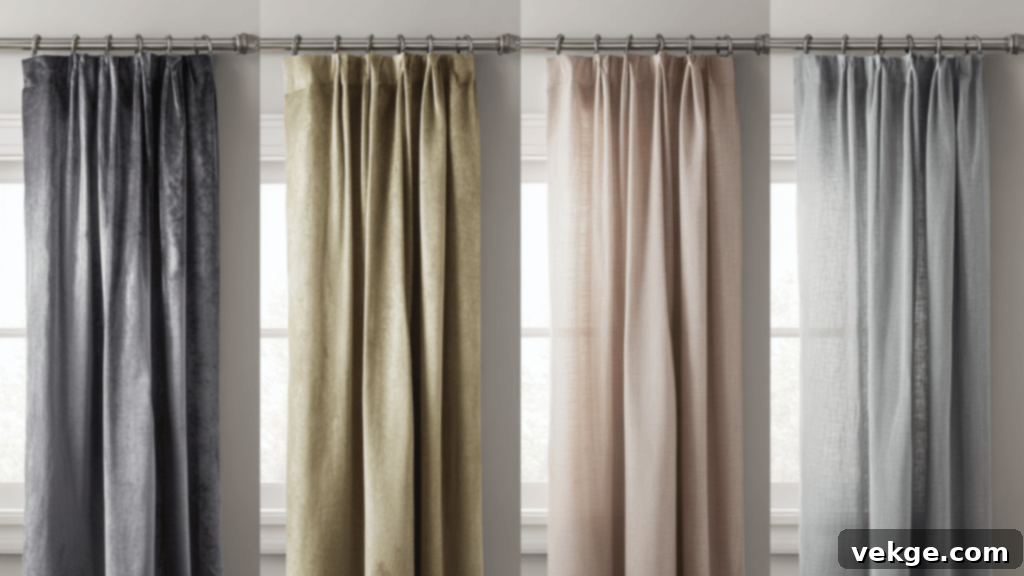
The type of fabric you choose significantly impacts how your curtains drape and achieve fullness. Certain materials inherently hang more smoothly and create more luxurious folds. Heavier fabrics such as velvet, linen blends, or cotton sateen tend to create fuller, more structured pleats and a rich visual texture. These materials inherently look more expensive and substantial, even with standard fullness ratios. Lighter fabrics like sheer linen, voile, or light cotton can also achieve a beautiful fullness, but they might require a slightly higher fullness ratio (closer to 2.5 or even 3 times the window width) to achieve a truly opulent and substantial look, as they naturally have less body.
Conversely, stiff, synthetic, or very thin fabrics may struggle to gather gracefully, often resulting in a flat or rigid appearance, even if the width calculation is correct. Always consider the fabric’s natural drape and texture before making your final selection. Getting both the right width and the appropriate fabric type ensures your curtains frame your window beautifully, move gracefully, and exude the polished elegance you desire.
Custom vs. Ready-Made Curtains: Making the Right Choice
The decision between custom-made and ready-made curtains often boils down to a balance of budget, desired aesthetic, and the unique characteristics of your windows. Both options offer distinct advantages, and understanding when to choose one over the other is key to achieving a successful window treatment.
When Custom Curtains Are a Worthwhile Investment
Custom curtains, while a greater initial investment, are the ultimate choice for achieving a truly bespoke and perfectly tailored look. They are particularly ideal for unique or challenging window situations and when you demand a specific design vision. Custom options are worth considering if:
- Your Ceilings Are Higher Than 9 Feet: Finding ready-made curtains longer than 108 inches can be difficult. Custom options allow you to achieve elegant floor-length or puddled styles for soaring ceilings.
- You Have Oddly Sized or Shaped Windows: Bay windows, arched windows, extra-wide or extra-narrow windows, or non-standard height windows often require custom solutions for a precise fit that ready-made options simply cannot provide.
- You Desire Exact Precision in Length: For a perfect “kiss” or a beautifully proportioned “puddle,” custom curtains guarantee the precise length needed, eliminating guesswork and costly alterations.
- You Need Specific Fabric, Color, or Lining: If you’re matching a unique decor scheme, require a specific texture, pattern, or need specialized linings (e.g., thermal, blackout, noise-reducing) that aren’t available in ready-made options, custom is the way to go.
- You Prioritize Durability and Quality: Custom curtains are typically made with higher-quality fabrics and superior craftsmanship, ensuring they will last for many years and withstand daily use.
While custom curtains undoubtedly cost more, they offer an unparalleled tailored fit, design flexibility, and quality that can significantly elevate the perceived value and sophistication of your home.
Measuring Tips for Non-Standard Windows
When dealing with windows that deviate from the norm, meticulous measurement becomes even more critical:
- For Wide or Tall Windows: Don’t just measure the glass. Measure the full width and height of the entire window opening, including any molding or trim that the curtains will cover. For extra-wide windows, you may need multiple panels or a single, extra-wide custom panel to achieve proper fullness.
- For Arched, Bay, or Floor-to-Ceiling Windows: Carefully sketch out your window and note all relevant measurements. For bay windows, measure each section individually to ensure rods and panels conform to the angles. For arched windows, remember to measure from the planned rod placement *above* the arch to the floor.
- Always Double-Check: Measure at least twice, and if possible, have a second person verify your measurements. Small errors can be costly.
- Consider Professional Help: If you feel overwhelmed or are dealing with particularly complex window treatments, consulting with a professional curtain designer or installer can be a wise investment. They can offer expert advice, precise measurements, and ensure a flawless installation.
By taking extra care with measurements for non-standard windows, you ensure your curtains hang beautifully and fit perfectly, making guesswork a thing of the past.
Wrapping Up Your Curtain Length Journey
You’ve now navigated the ins and outs of curtain length, equipping yourself with the essential knowledge to confidently choose the perfect window treatments for every room in your home. This comprehensive guide has provided you with the foundational skills to measure accurately, understand the nuances of various hanging styles like float, kiss, and puddle, and match each look to the specific needs and aesthetic of your space.
Remembering common mistakes will prevent you from making those easy-to-miss errors that can detract from an otherwise beautiful room. You now understand how thoughtful rod placement can create an illusion of height and how curtain fullness contributes to a luxurious drape. Whether you opt for ready-made or custom solutions, your newfound expertise will ensure your curtains are a focal point of style, not a source of frustration.
Take a moment to truly observe your windows and consider the mood you wish to cultivate in each room. Do you envision a crisp, clean, and modern line, or something more dramatic, opulent, and flowing? The beauty of curtain design lies in its versatility and its power to transform. With your tape measure in hand, take your time, measure carefully, and don’t hesitate to opt for longer panels—often, that extra length is precisely what provides that coveted, polished, and high-end finish.
Curtains are more than just functional coverings; they are an integral part of your home’s personality. By applying these tips, you’re not just hanging fabric; you’re crafting an atmosphere. Need more easy home styling tips and inspiring ideas? Explore our other blogs filled with helpful, doable ideas designed to keep your space looking and feeling its absolute best.
